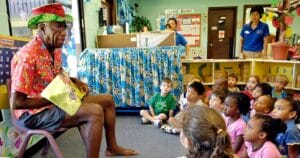You might know him as “Famous Amos” for his cookies, but he was well known long before that. Born in Florida, at 12 his parents split up and he moved to New York City to live with his aunt, Della Bryant. Amos showed aptitude in cooking, and attended the Food Trades Vocational High School there. But he dropped out after two years to serve in the U.S. Air Force, stationed at Hickam Air Force Base in Honolulu, Hawaii. He earned a high school equivalency diploma before his discharge, and returned to New York. He attended secretarial school and took a job at the William Morris Talent Agency, working his way up from the mail room to become, in 1962, the agency’s first Black talent agent. As head of the agency’s Rock ’n’ Roll department, he signed Simon & Garfunkel, as well as The Supremes, and represented The Temptations, Diana Ross, Sam Cooke, Marvin Gaye, and others. He attracted clients by sending them very tasty chocolate chip cookies, using a recipe from his Aunt Della. Also in the package: an invitation to visit him to talk about representation. In 1967, still facing racism despite his success as an agent, he quit Morris, moved to Los Angeles, opened his own agency, which struggled when he could only attract “second-tier” talent.
He still used cookies as his calling card, and in 1975 he borrowed $25,000 from singers he knew, including Helen Reddy and Marvin Gaye, and opened the first Famous Amos cookie store, on Sunset Blvd. in Los Angeles. It was a hit, with $300,000 in sales the first year — the equivalent to about $1.75 million today. After 5 years, sales hit $12 million. The Smithsonian got one of his trademark outfits — his Panama hat and colorful Indian shirt — for its collection. President Ronald Reagan presented Amos with one of the first Awards of Entrepreneurial Excellence. And other companies leapt into the high-end cookie business to compete. The company floundered, and started losing money; Amos finally lost control. “The thing that got us in trouble is when I tried to actually run the business,” he told the Los Angeles Times. “That’s not what I want to do. I’m a promoter.” He even lost the right to use his own photo on any business products, or use his name to promote any new businesses. To make ends meet he tried a new cookie brand, which he dubbed “Uncle Noname”.

Keebler took over the Famous Amos brand in 1986 — the fifth company to own it — and brought Amos in to help fix the brand. “Somehow or another caramel coloring had been added and I don’t know why that was,” Amos said. “And they were using a real low-grade vanilla flavoring, and I always used vanilla extract. One of the first things I shared with Keebler when we met was that I couldn’t promote the product they were currently selling, that if I were going to be a part of it we had to make some adjustments so that it could be closer to a Wally Amos product.” They agreed. Around that time I met his son, Gregory Amos, who was working at NASA’s Jet Propulsion Laboratory — as a secretary.
His father’s comeback didn’t last long: last time I tried the “Famous” brand cookies, they were back to a low-quality recipe. Amos pitched a new brand, “Cookie Kahuna” on the Shark Tank show in 2016, and didn’t get a deal. He folded that business in 2018. But Amos remained philosophical. “If you sit around starting to feel sorry for yourself, and blaming everyone else for your position in life, it is like being in quicksand,” he said. “In quicksand, if you start flailing all about and panicking with each movement you go in deeper, but if you just stay calm and look about, chances are you’ll see a twig or something you can reach to pull yourself out. Or, if you stay there long enough someone will come and rescue you.” As for his fame, he finally concluded that “Being famous is highly — very, very, very highly — overrated.” He died at his home in Honolulu on August 13, of complications from an unspecified form of dementia. He was 88.
